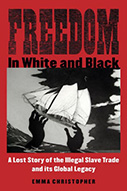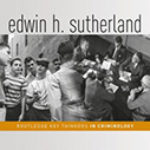Freedom In White And Black: A Lost Story Of The Illegal Slave Trade And Its Global Legacy

Author: Emma Christopher
Publisher: Madison: The University of Wisconsin Press, 2018. 310p.
Reviewer: Kenneth Morgan | January 2019
Emma Christopher’s book provides an intriguing narrative dealing with the consequences arising from the burning in 1813 of a small British-operated West African slave factory by its owners in order to avoid seizure by the Royal Navy antislavery patrol. The compound was situated to the south of Cape Mount in what would now be Liberia. It was conducting its affairs illegally just a few years after Britain and the United States abolished their slave trades in 1807 and 1808. During the chaos that occurred at the burning factory, captives were set free from their barracoons. Some 233 enslaved Africans were liberated by the antislavery patrol and brought to Freetown, Sierra Leone for court proceedings. The torching of the slave factory, described vividly here, generated a considerable tranche of paperwork that included some rare testimonies from freed slaves. It was the discovery of these documents that provided the impetus for researching this book.
The author has written a microhistory of the main black and white participants connected to the slave factory, and has undertaken imaginative, meticulous research on several continents to piece together the fate of the black and white people involved. This human interest is contextualised by broader considerations dealing with the history of the transatlantic slave trade in an era when extended abolitionist pressure was impinging regularly on British and American citizens who continued to participate in an illegal slave trade. Though the emphasis is on narrative exposition rather than an analytical contribution to debates on the slave trade, sufficiently interesting new material is provided to justify the attention of historians specialising in slavery and abolition in the modern world.
The slave factory was run by Robert Bostock, descended from a Liverpool slave trading family, and Charles Mason, an American partner, with assistance provided by John McQueen, a Scotsman. Bostock and Mason had worked together as slave traders since 1808 in the Gallinas, on the Windward Coast, and began trading at their slave factory two years later. They chose its location carefully as a place where long sea bars along the coast separated slavers from large ocean-going vessels attempting to intercept them. Their slave factory conducted its operations for three years before the conflagration mentioned above. Christopher states that ‘their trade swelled to a size never seen when it had all been legal’ (p. 49), but provides no supporting figures. This is perhaps not a crucial issue, however, in this context because the book is focused on the fate of the black and white people connected to the slave factory rather than offering a quantitative study.
Bostock and McQueen were captured, handcuffed and taken to Freetown where they pleaded guilty and were sentenced under the 1811 Slave Trade Felony Act to fourteen years’ convict transportation to Australia. Mason continued slave trading until 1816 when he was captured by an English naval vessel. He escaped a court sentence because he was a US citizen, but died in a shipwreck while crossing the Atlantic to Cuba later that year. In 1815 Bostock and McQueen arrived in Sydney where they were soon pardoned. Bostock returned to England to defend in court his activities as the co-owner of a slave factory. Ironically, his conviction was overturned: he had been wrongly charged under the Slave Trade Felony Act because his slave factory was not in British territory. In 1816 Bostock and McQueen went into the retail business together in Sydney. McQueen became a successful storekeeper in Sydney. He died in 1829. Bostock moved to Van Diemen’s Land as a free settler where he became a storekeeper, living in Hobart until his death in 1847.
Christopher provides more details about the African victims in this saga than is commonly the case with books on the slave trade. She draws upon three factory slave testimonies by Tom Ball, Yarra and Tamba. Two of the rescued slaves, David Noah and Tamba, joined the Church Missionary Society after their liberation; they sent letters and journals to London that are drawn upon in the book. Chapter 2 corrals snippets of evidence together to outline the background environment of Tamba, a member of a small ethnic group, the Kissi; but there is no information about how and when he was enslaved. Some good testimony is included from Yarra and Tom Ball about their work at the slave factory, but it is briefer (see pages 106-7, 186) than one would expect from the announcement of this material – a fairly rare archive survival – at the beginning of the book. In fact, the information provided by these testimonies is, disappointingly, a bare factual account; there are no comments about what these Africans felt about helping Bostock, McQueen and Mason to ship enslaved Africans across the Atlantic.
The key strength of Freedom in White and Black is to follow through the lives of the recaptured Africans after they were set free. This shows that they undertook various lines of employment in Sierra Leone. Some worked on coffee plantations; others were recruited aboard naval vessels; still others joined black military regiments in Freetown. Female liberated Africans were employed as domestic servants, or they set up households with white settlers. Most of those liberated performed manual labour in the hills near Freetown. Christopher underscores the point that the British abolitionists, despite their commitment to antislavery naval patrols, failed to understand what newly-freed slaves could and would do for employment or what freedom really meant for these people. Moreover, most of the re-captives had little idea about what they should do after they were liberated. One is left with the impression that the white people involved in this story benefited from a fair amount of luck and started afresh with new opportunities in another part of the British Empire (Australia) after blotting their copybook in West Africa — but that the freed Africans from the slave factory found it difficult to pursue their lives successfully in Sierra Leone. This conclusion is not surprising given the divisions in race and power outlined in the book.
Kenneth Morgan, Brunel University London


